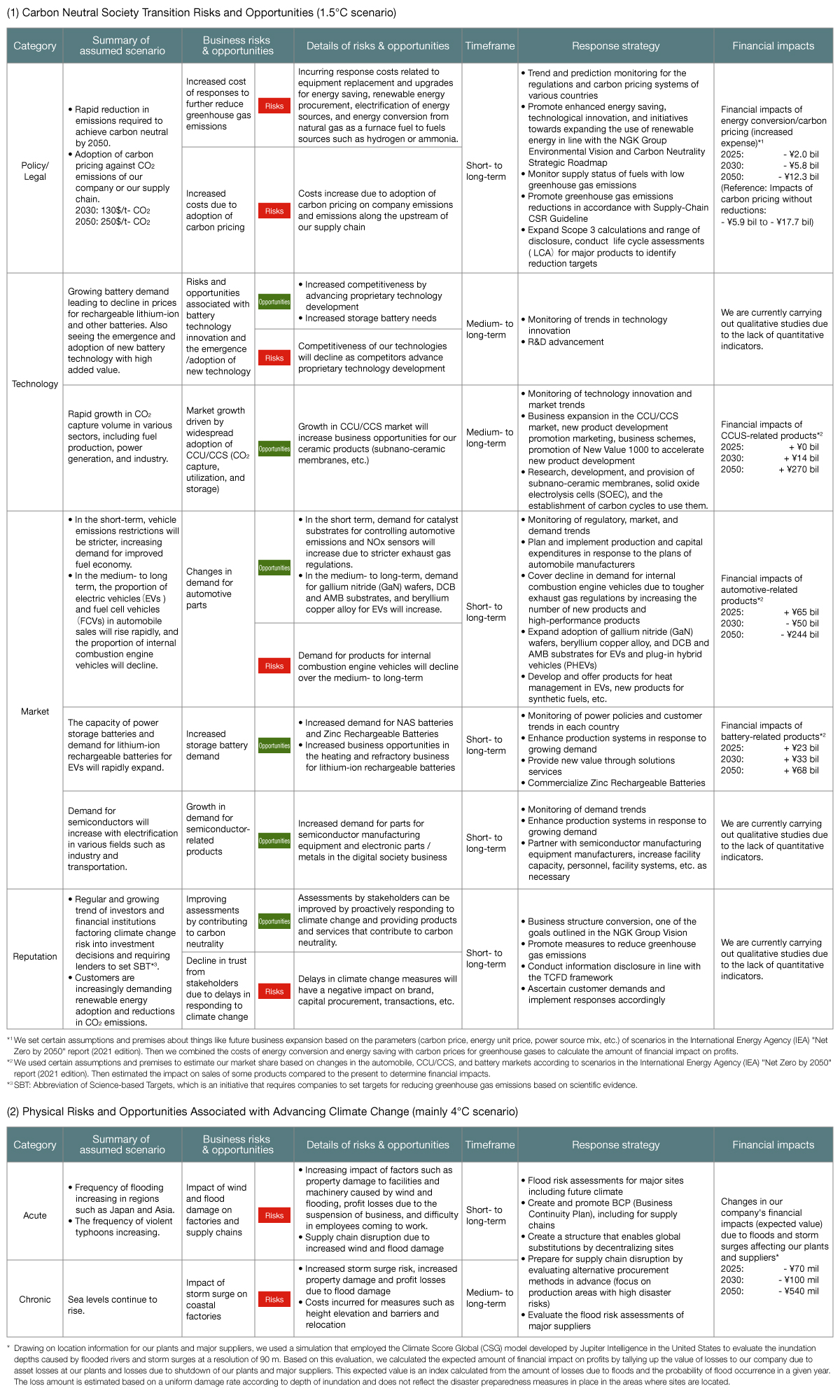Sustainability
Information Disclosure Based on TCFD Recommendations
In February 2020, the NGK Group announced our support for recommendations issued by the Task Force on Climate-related Financial Disclosures (TCFD) created by the Financial Stability Board (FSB). Since then, we have evaluated how to apply the TCFD framework towards resolving issues facing our Group operations, such as the risks and opportunities posed by climate change, and towards necessary information disclosure.
Below, we disclose information related to scenario-specific analyses conducted based on the four themes outlined in the TCFD recommendations: governance, strategy, risk management, and metrics and targets.
We will continue to expand analysis work and enhance information disclosure as part of our commitment to communicating with our stakeholders. We will accurately identify climate change-related influences on Group operations and implement response measures to promote sustainable growth for our business.

The Task Force on Climate-related Financial Disclosures (TCFD) was established by the Financial Stability Board (FSB). As of November 24, 2023, following the dissolution of the TCFD, 1,488 companies and organizations have expressed support for TCFD recommendations.
Governance
In April 2021, we announced the NGK Group Vision: Road to 2050. In this Group Vision, we position responding to ESG issues as a core management theme and outline the goal of being a company that contributes to carbon neutrality and the digital society using our ceramic technologies. Recognizing climate change response as one of the highest-priority issues to achieving sustainability for our planet, we drafted the NGK Group Environmental Vision as an extension of the NGK Group Vision. In this Environmental Vision and our Carbon Neutrality Strategic Roadmap, we outline achieving net zero CO2 emissions for our business activities by 2050. Specific activities include setting management metrics and goals for each fiscal year of our 5-Year Environmental Action Plan. Our Sustainability Management Committee chaired by the President deliberates on these metrics and goals at least once a year, and issues reports to our Board of Directors. We also have incentivized CO2 emissions reduction by adding achievement benchmarks to the performance-linked bonus evaluation criteria for directors and executive officers. Members from relevant divisions participate in Environment Action Subcommittee within the Sustainability Management Committee to evaluate measures for information disclosure based on TCFD recommendations. The subcommittee's results are then deliberated by the Sustainability Management Committee before being reported to the Board of Directors. This subcommittee is also focused on achieving carbon neutral business activities by no later than 2050, one of the goals outlined in our Action Plan. The subcommittee works towards this goal by also promoting measures such as energy saving and furnace fuel conversion from fossil fuels to carbon-free fuel. The Sustainability Management Committee submits reports on its deliberations, including ESG issues such as our disclosure response for the CDP, to the Board of Directors at least once per year.
NGK Group Environmental Vision
Framework Related to Climate Change Response

Risk Management
The Risk Management Committee handles NGK Group-wide risks, including risks related to climate change, by establishing policies, strategies, frameworks, measures, and annual plans for risk management. It also monitors the overall execution status of risk management and reports to the Board of Directors when appropriate. In addition, individual risk items are the responsibility of the head of the department or committee that should manage and monitor them, and are handled by the relevant department or committee. In the event that disasters or accidents occur, they are handled according to the Basic Rules of Crisis Management, by the department or committee specified by these rules. In cases of particularly serious risks, the Executive Officer in charge of the Sustainability Management Department may decide to convene a response committee, which includes participation by the President, to address said risks.
Risk Management Framework
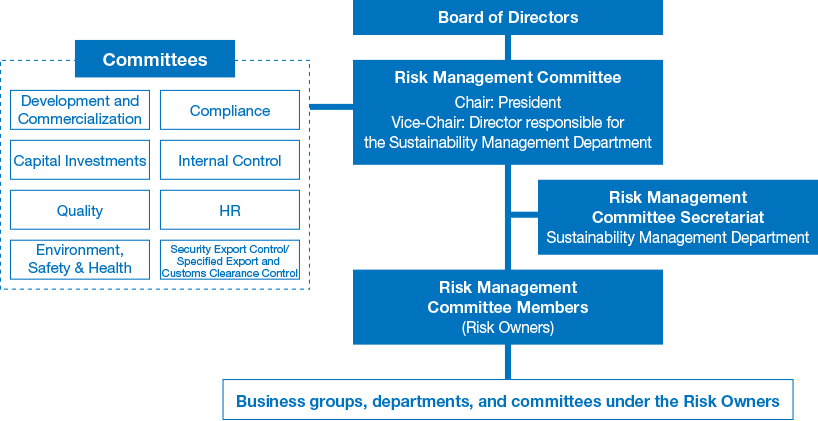
Risk Management Process
In addition, for risks related to climate change, the Environment Action Subcommittee within the Sustainability Management Committee creates scenarios and conducts a scenario analysis to identify Materiality risks. Through this process, we extract risks and opportunities, and draft response strategies. These results are deliberated by the Sustainability Management Committee, then reported to the Board of Directors.
Materiality Risk Management Cycle
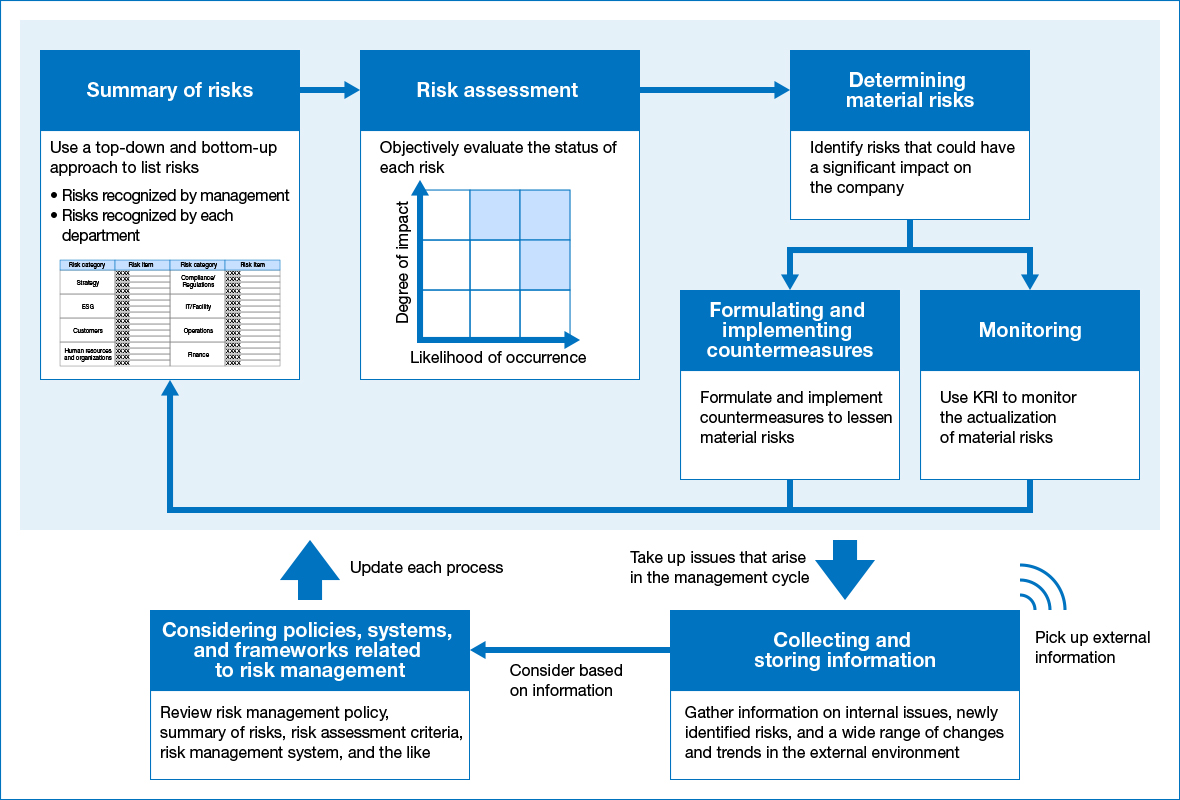
Strategy
Climate Change Risks and Opportunities
We have set time frames and scenarios to analyze the risks, opportunities, and magnitudes of the impact of climate change in relation to NGK Group business.
Scenario analysis is a method for postulating multiple future scenarios and ascertaining the impacts of the risks and opportunities posed by climate change on the NGK Group. The goal is to use the insights gained in considering future strategies and responses.
Assumptions
Timeframes
We set short-term, medium-term, and long-term timeframes for considering risks and opportunities.
| Timeframe | Reason for setting | |
|---|---|---|
| Short-term | FY2025 | Final fiscal year of the fifth 5-Year Environmental Action Plan |
| Medium-term | FY2030 | Interim goal year of the NGK Group Environmental Vision |
| Long-term | FY2050 | Goal year of the NGK Group Vision and the NGK Group Environmental Vision |
Scenarios
We have set 1.5°C and 4°C scenarios under which the risks and opportunities of transitioning to carbon neutrality, and the physical risks and opportunities of climate change, are each maximized.
| Scenarios | Summary | Main external scenarios used as reference |
|---|---|---|
| 1.5°C Scenarios |
Rapid changes in policy, regulatory systems, and markets to aim for carbon neutrality by 2050 and limit the average global temperature increase to 1.5°C compared to pre-industrial revolution temperatures. |
|
| 4°C Scenarios |
Lack of progress in government policy, regulatory systems, or social initiatives result in an average global temperature increase of 4°C compared to pre-industrial revolution temperatures. Massive impact from disasters and other events caused by climate change. |
|
Particularly Important Risks and Opportunities
We have identified risks and opportunities in line with the TCFD categories for each time frame and scenario. We conducted qualitative assessment of the magnitude of financial impact of each risk and opportunity with reference to the risk assessment criteria of all Group companies. We also quantified the financial impacts for some items that were thought to have a certain impact and could be quantitatively assessed based on these scenarios.
Furthermore, this scenario analysis is not a forecast of NGK Group performance, but rather analyzes the impacts of the risks and opportunities posed by climate change on the NGK Group under each scenario. It is intended to be used in considering strategies and responses from here on out. The information used to calculate these financial impacts is the information available at the time of the examination, and contains uncertainties and assumptions.
Nickel-Zinc Rechargeable Battery
Strategy Based on the Risks and Opportunities of Climate Change
We will pay close attention to both societal and market trends, while recognizing the degree of impact of each of the risks and opportunities we have identified through scenario analysis. And we will take action according to the response strategies we have established for each item.
Among the transition risks are risks accompanying CO2 emissions. We will mitigate these risks by promoting initiatives aimed at net-zero CO2 emissions according to our Carbon Neutrality Strategic Roadmap. We are already implementing measures to deal with water-related disaster risks from the standpoint of business continuity planning (BCP). For instance, we are raising land in response to the frequent occurrence of heavy rainfall. With respect to further disasters, we are taking measures to prevent catastrophic damage, with protecting human life as our highest priority. We are aware of the future risks posed by climate change, including those posed by the worst-case scenario of a 4°C increase in temperature. To mitigate these risks, we will continue to evaluate risks while working to strengthen countermeasures such as BCP.
NGK Group Environmental Vision
Carbon Neutrality Strategy Roadmap
The NGK Group Vision defines our vision as A Company to Contribute to Carbon Neutrality and Digital Society with Our Unique Ceramic Technologies. It also sets a target for products related to these fields to make up 80% of sales by 2050. We used this scenario analysis to calculate the quantitative financial impact on parts of our business that can be assumed at present. This allows us to determine the business opportunities presented by realization of a carbon neutral society. We will continue working to develop new products related to carbon neutrality and digital society to achieve the NGK Group Vision, and aim to provide new value to society as we strive for sustainable growth.
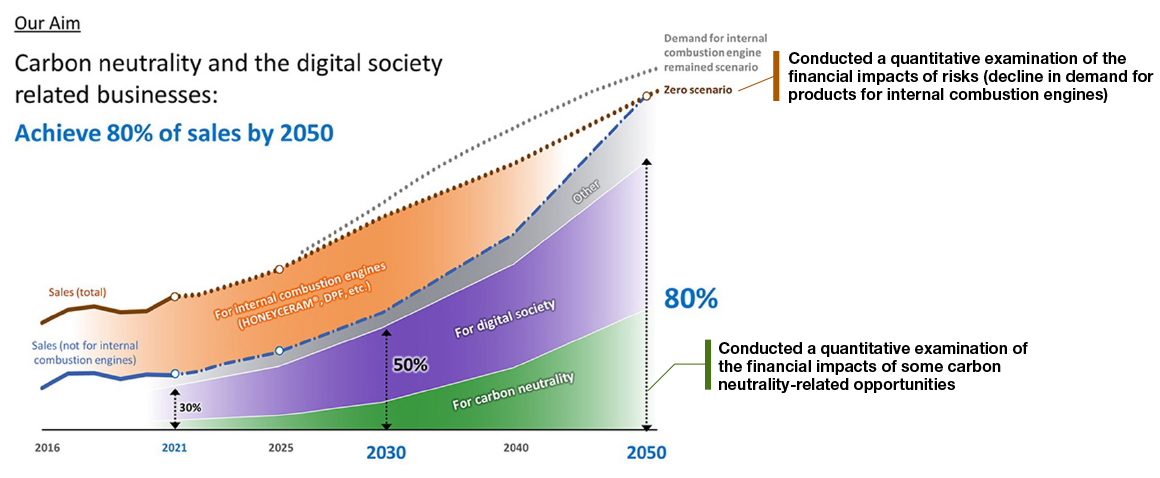
We intend to suitably enhance and deepen our scenario analysis by adding and updating various parameters and external reference scenarios depending on the state of new product development. And we will continue analyzing and considering responses to the impacts that the risks and opportunities posed by climate change can have on our business.
Metrics and Targets
We drafted the Carbon Neutrality Strategic Roadmap to promote goal achievement that will enable us to realize the NGK Group Environmental Vision. We set milestone targets ahead of our 2050 goal of net zero CO2 emissions for the entire Group. These milestone targets call for a 500,000 ton reduction in emissions by 2025 (32% reduction compared to 2013 (reference year)) and a 370,000 ton reduction by 2030 (50% reduction compared to 2013).
When the roadmap was first formulated, the target value for fiscal 2025 was set at 550,000 ton (25% reduction compared to 2013), but this was revised to aim for an even higher reduction rate.
Carbon Neutrality Strategic Roadmap
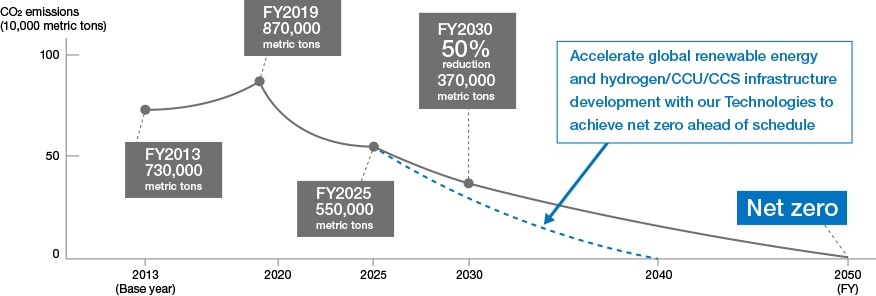
Four Strategies of the Carbon Neutrality Strategic Roadmap
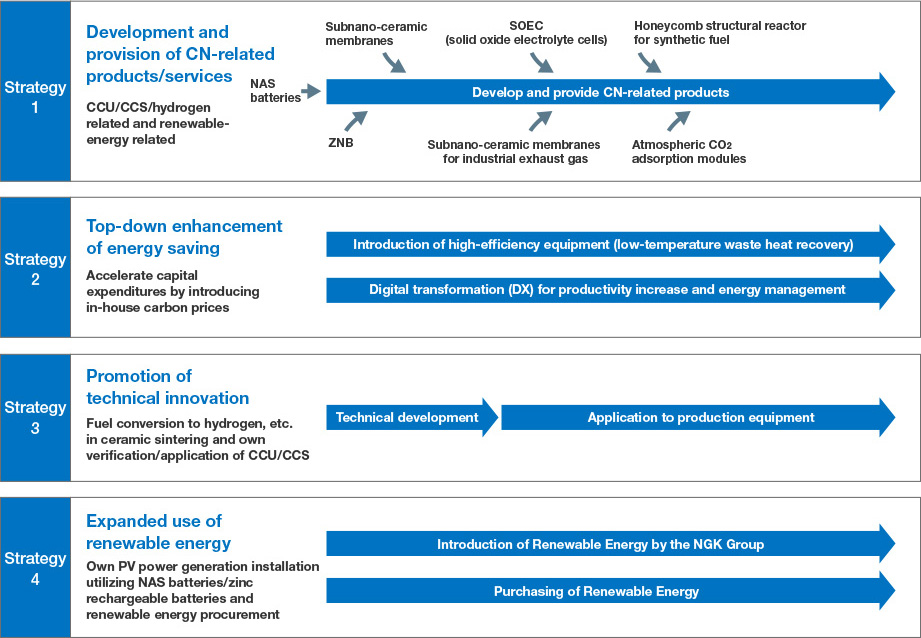
NGK Group Environmental Vision
We drafted our fifth 5-Year Environmental Action Plan to help realize the NGK Group Environmental Vision. This plan outlines targets for the environmental activities we will conduct between FY2021 and FY2025.
The objective of this Plan is to make it easy to understand our progress towards net zero by 2050 and our 2030 milestone target of a 50% reduction compared to 2013. As part of our initiatives to expand our use of renewable energy, we set new targets for renewable energy utilization rates that we apply to electricity consumption for the entire Group. We also set targets to increase the number of products registered as carbon neutral-related products.
5-Year Environmental Action Plan
(Disclosed in May 2023)

